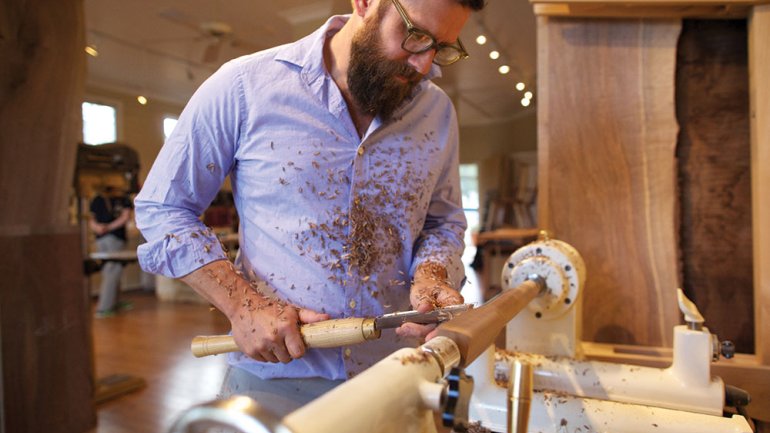West by Midwest
West by Midwest
It makes sense that Geoffrey Keating, a fifth-generation woodworker and furniture maker, was drawn to an 1897 grocery with turn-of-the-century character, which he transformed into his studio and home.
In a less direct way, it makes sense that Keating finds inspiration in the music of Justin Townes Earle. Think about it like this: Earle starts with the venerable traditions of American folk, blues, and country music, and combines them into his own sound. For Keating, a similar transformation takes place when he works with wood.
His furniture is suffused with time-honored qualities: patient, well-honed craftsmanship, a classic aesthetic, and a deep love of wood, along with 21st-century functionality and a twist of contemporary design. “But aesthetically it’s not strictly modern,” the 37-year-old artist says, speaking from his home/studio in Colorado Springs, Colorado, where he and his wife, Anna, and their toddler son settled in 2012, to be close to Anna’s family. “I like figuring out when to get out of the way and let the wood do the work for you. I like leaving enough space for simplicity, so the focus is on the wood itself.”
Despite woodworkers in the family going back to his great-great-grandfather, Keating’s focus growing up in Amarillo, Texas, was not on wood. He knew the family lore, of course: His forebears built churches around West Texas and Arkansas, in an era when such work meant not only framing, but also hand-carving interior details such as altar railings and wooden pews. By the early 1990s, his uncle was the only one still occasionally practicing the craft. And as a typical willful teenager, Keating had other things on his mind.
For two years after high school he traveled the country as a motorcycle mechanic for his brother, a professional racer. Later, after earning a master’s in theology at the University of Notre Dame, he considered a teaching career. He earned a second master’s in theology from Yale and was back at Notre Dame, well on his way to a PhD, when woodworking stopped him in his tracks.
“Woodworking was always lingering in the back of my mind. In school I’d started doing it to keep my sanity and do something with my hands,” he explains. Living in South Bend, Indiana, Keating began building desks and other wooden office furniture for professors, keeping busy through word of mouth. He soon realized his interest in teaching was waning as his passion for woodworking grew. (“Religion still plays a prominent role in my life,” though, he notes.) By 2008, after leaving academics, he was creating heirloom-quality furniture full time.
From the start, Keating has worked from his own designs. He’s especially drawn to traditional lines and shapes – early American spindle-back chairs, sideboards, and high writing desks among them – to which he adds a subtle, sophisticated flair. With his academic background and love of books, Keating has a particular fondness for desks, incorporating elements from an earlier era, including map, apothecary, and printmakers’ drawers.
“I love bringing back a sense of warmth, durability, and longevity in office furniture,” he says. “We put so much time into the living area, but oftentimes our work space gets left out of the mix.”
Almost all the wood Keating uses is American black walnut or claro walnut, and it’s salvaged or certified sustainably harvested. And, as was true of his forebears’ craft, sustainability also means furniture whose enduring design and exceptional workmanship, including traditional joinery and hand-rubbed oil finishes, make it worth handing down through generations. The one woodworker Keating cites as an indirect influence is Wharton Esherick, particularly in such subtle aspects as edges with a delicately sculpted, organic feel.
Ideas are also stirred up by sources as varied as haystacks in a field, antique library furniture, forms from nature, and the creative energy of artists in many genres. When not in the shop, Keating spends time in art galleries and museums, and in the mountains near his home. “It’s good to clean your eyes from the daily routine and do things to hit the reset button in the recesses of the brain,” he says.
Keating’s move to Colorado was a major reset, which coincided with a surge of national and international interest in his work, thanks to his participation in the 2012 Architectural Digest Home Design Show in New York and inclusion in Architectural Digest Germany’s watch list for up-and-coming designers. While his basic design aesthetic hasn’t changed, in recent months he has broadened his scope to include collaborations on upholstered pieces and bronze furniture elements. He is working with Texas multimedia artist Chau Nguyen on upholstery fabric designs and has teamed up with a local foundry worker to cast pedestals in bronze for his hardwood tables.
Looking further into the future, Keating marvels at how his furniture-making career seems to have come together smoothly and quickly thus far, “so a big part of my goals is to continue what I’m doing,” he says. But one thing will change. His tongue-in-cheek tagline, which for years placed him in the Midwest, now reflects his new geographic status as well as his continued strong allegiance to the time-tested values of his craftsmen ancestors: “Made in the American West with My Own Bare Hands.”
Gussie Fauntleroy is a Colorado-based writer who contributes regularly to national and regional publications on art, architecture, and design.

